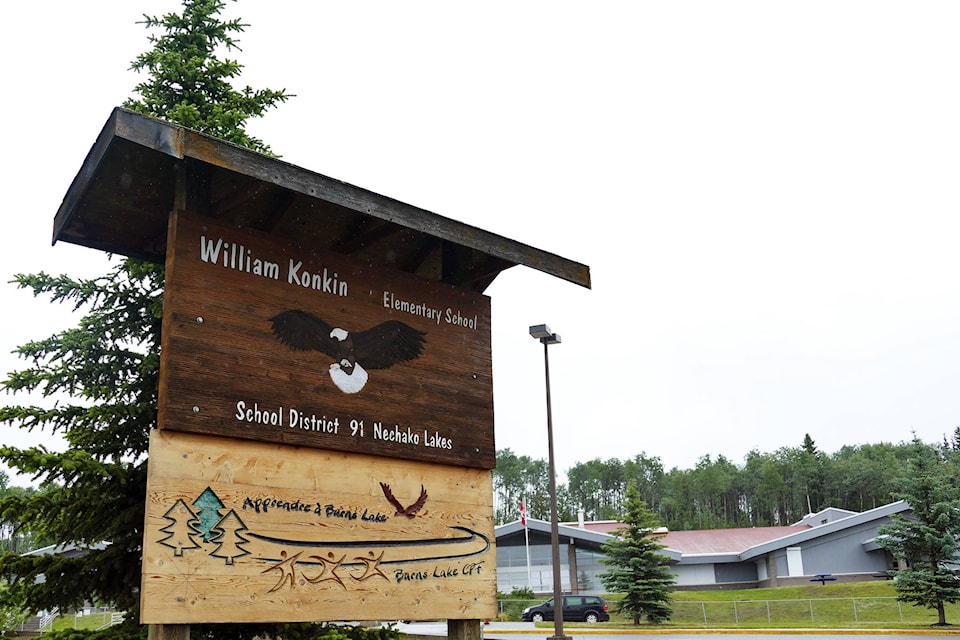Northern Health has identified a confirmed COVID-19 exposure incident at William Konkin Elementary (WKE) School in Burns Lake.
On Nov. 23, WKE, under the direction of Northern Health (NH), sent home letters informing families of a confirmed COVID-19 exposure incident that occurred at the school last week.
The letter said, “The Northern Health Authority has informed the principal of William Konkin Elementary School that students and staff may have been in contact with a lab-confirmed case of COVID-19 on November 16, 2020.” It goes on to discuss how COVID-19 spreads and what the process followed by NH and the school district would look like.
School District 91 superintendent Mike Skinner assured that the school was taking all the necessary protocols and said in an email to Lakes District News that “the local health authorities in BC take the lead on all COVID related matters and schools districts follow their procedures for school exposures.”
Eryn Collins, the media representative for NH gave additional information on the exposure and said, “It does not mean that anyone needs to take any action; does not mean children or staff have been exposed to COVID-19. Contact tracing for cases regardless of whether they are part of school community or otherwise, still takes place; unless someone is directly contacted by public health, you don’t need to take any action and children should continue going to school. It is really meant to reassure community that proper follow-up is being done.”
Collins also explained that when a confirmed case of COVID-19 is identified as being part of the school community, it meant that a staff member or a student may have been at school while they were potentially infectious, but that doesn’t mean that anyone in particular has been exposed.
ALSO READ: 41 COVID-19 cases associated with the LNG Canada site outbreak in Kitimat
She also said that the person exposed, would be in isolation and being monitored daily by public health.
Apart from monitoring the person exposed, NH has also been doing contact tracing and following all the protocols when such an exposure event takes place.
“If people are identified as close contacts, they are notified and they are advised to self isolate and monitor for symptoms for 14 days; if they develop symptoms, yes absolutely they will be tested,” she said, adding that for asymptomatic people, it will depend on circumstances and what the level of risk is, but as has been the approach province-wide, asymptomatic testing is done in certain circumstances but broadly is not that effective. She said that such testing can have high rates of false negatives or false positive results and so, if someone was advised to self isolate for 14 days and were tested, while asymptomatic, they would still need to self isolate for 14 days because a negative test when they are asymptomatic, would not mean that they couldn’t develop symptoms further along in that period, and that tests positive.
Collins also said that self-isolation is the best solution once they are identified as close contact and notified by public health, but others who are not considered close contacts and are not contacted by public health, do not need to self-isolate, they just need to be monitoring for symptoms.
She also explained how contact tracing during such exposure events would work.
“For contact tracing, what is considered as close contact is a very specific thing; you need to have been in prolonged, very close contact with the individual who is contagious so for the broader community, it’s not a concern,” she said, assuring that if there were a concern that the public health was unable to reach out directly to the close contacts of an individual who was tested positive, regardless of whether it is a school community, confirmed case or not, if there was a concern that they are unable to contact those who might be at risk directly, public health would then issue a public exposure alert, which would then let others know that they may have been exposed to a potential infectious case.
“I would just reiterate that if your school or child’s school has received a notification, it does not mean that your child has been exposed, if they are not contacted by public health or school authority, you do not need to take any action,” she concluded.
READ MORE: How do the leading COVID vaccines differ? And what does that mean for Canada?
Priyanka Ketkar
Multimedia journalist
@PriyankaKetkar
priyanka.ketkar@ldnews.net
Like us on Facebook and follows us on Twitter.
